If you’re like me, you prefer to know what’s coming, rather than be caught off guard. When you know what the first signs of menopause (change of life) are, it can prepare you mentally and emotionally for a condition no female can escape. No surgery is available for this problem…sorry!
What does menopause mean? Menopause is defined as “the end of menstruation. While technically it refers to the final period, it is not an abrupt event, but a gradual process. Menopause is not a disease that needs to be cured, but a natural life-stage transition.”
Source: http://medical-dictionary.thefreedictionary.com/Menopause
Keep in mind that this article serves to inform you of the signs and symptoms of menopause; not with early menopause signs. Early menopause (aka premature menopause) is defined as menopause that occurs at an age that is younger than the expected average age for menopause which typically is between 45 and 55. Both “normal” menopause and early menopause symptoms are the same.
Menopause occurs when hormone production (estrogen and progesterone) by the ovaries drops to a level where menstrual cycles no longer continue. In men, the loss of the male hormone testosterone causes menopause in men, known as andropause.
Once you’ve had the absence of your menstrual cycle for 12 months, it signals the end of your fertility period and the beginning of menopause, also known as postmenopause. The average age of menopause is 51. Some women get menopause as late as age 60, although this is rare.
Menopause is preceded by a transitional period known as perimenopause (pre-menopause). It is also during this time that the worst of the menopause symptoms are experienced. So, how long does menopause last? On average perimenopause lasts for about four years; some women, however, have experienced the symptoms for as long as ten years, others for several months only. Also called the menopausal transition, it occurs when the body moves from the regular menstrual cycle of about 28 days to irregular cycles which are lighter, shorter, heavier, longer, and also missed a period. To avoid unwanted pregnancy, it is recommended you use contraceptives until such time that you are officially menopausal, which occurs when you have missed your period for 12 months. This event then also marks the end of perimenopause and signals the start of menopause. This new life can potentially be very rewarding; our attitude will determine how well we handle menopause.
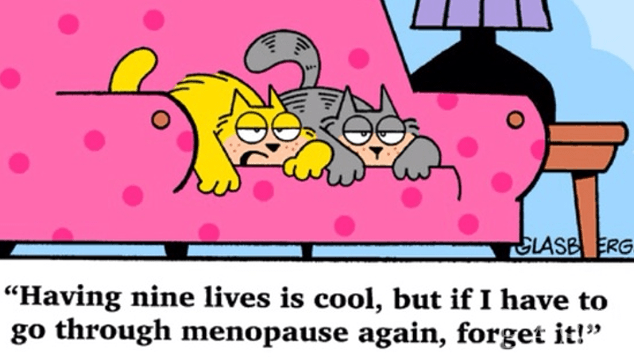
Page Contents
First signs of menopause and their symptoms:
OK, so let’s move on to the actual symptoms experienced by most that signifies we have reached this period in our life.
Fluctuation in your periods (menses) is probably the most significant symptom of perimenopause. “You may go months with a normal period, or months with one that’s so heavy you can’t leave the house. Your period may last for four days or two weeks. You may skip a month or have spotting between periods. You may find your period comes every 28 days or every 45 days. There just doesn’t seem to be any rhyme or reason to it.”
Source: http://www.healthywomen.org/content/ask-expert/1786/irregular-periods-and-perimenopause
Hot flushes: is another of the first signs of menopause which is experienced by up to 85% of menopausal women. Hot flashes (aka hot flushes) can last from 6 months to fifteen years. The most significant symptom of hot flashes is that sudden feeling of heat which rises up over your body felt most strongly in the neck and head. Usually accompanied by reddened skin.
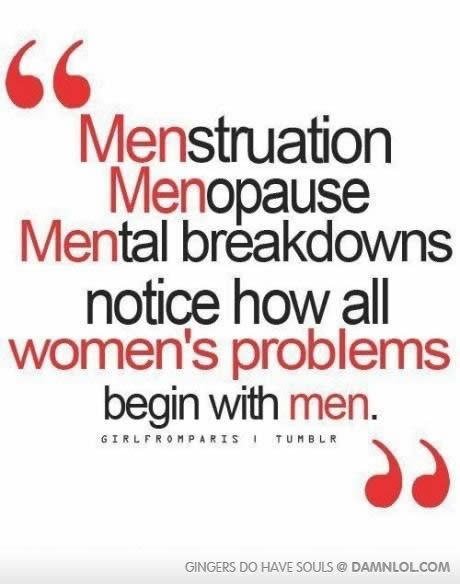
What causes hot flashes?
“…declining levels of estrogen as a woman approaches menopause are thought to be the underlying cause of hot flashes. A disorder in thermoregulation (methods the body uses to control and regulate body temperature) is responsible for the sensation of heat, but the exact way in which the changing hormone levels affect thermoregulation is not fully understood.”
Source: http://www.medicinenet.com/hot_flashes/article.htm
Sleep disorders like insomnia: Menopause and insomnia symptoms can be either temporary or chronic and severe. The main causes of sleeplessness are the symptoms typically associated with menopause, i.e. fluctuations in hormones, night sweats, irregular periods, etc.
Night sweats during menopause are medically termed sleep hyperhidrosis. It is heavy sweating which simply is the manifestation of hot flushes while you sleep. Symptoms generally include nausea, flushing, chills, headaches and sudden and intense heat.
Mood swings are a menopausal symptom that affects more than 50% of women. It is an extreme or rapid change in mood which is mostly disproportionate to what triggers it. Hormones responsible to control moods and emotions are out of balance, hence the mood swings. Symptoms of mood swings include, but are not limited to depression, aggressiveness, sadness, irritability, anxiety, nervousness, etc.
Vaginal dryness: menopause vaginal dryness is medically known as atrophic vaginitis. Since less estrogen is produced by the ovaries, it leads to thinning and drying of the vaginal walls. Symptoms of vaginal dryness that may occur as a result of the thinning include painful intercourse, discomfort, itching, urinary problems, and a vaginal discharge.
Weight gain and menopause are a given (for 90% of women anyway). Menopause weight gain typically involves increased amounts of fat around the abdomen which is not only attributed to a slower metabolism as a result of hormonal changes but also due to aging as well as an unhealthy lifestyle. Weight gain in women on average is between 12 and 15 pounds between the ages of 45 and 55 (menopausal years).
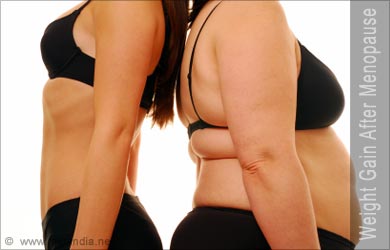
Breast tenderness is medically termed mastalgia, mastodynia, and mammalgia, and not unique to menopause. The term breast tenderness is used to indicate pain, discomfort, and sensitivity in breasts when they are touched or pressure applied to them. Breast tenderness is due to hormonal fluctuation and consequently also experienced by most women during pregnancy and menstruation. Other symptoms of breast tenderness are swollen breasts, aches, and pain while sleeping.
Menopause and sexuality: during menopause libido in most women decreases. The hormone imbalances caused by loss of estrogen and testosterone are largely to blame; other factors can however also contribute to low libido. These are stress, medication, depression, sleep disturbances, etc.
Fatigue: menopause tiredness is largely caused by a fluctuation in the levels of the hormones estrogen and progesterone. These hormones control the body’s energy levels and play a vital role in the body’s sleep function. Other hormones involved in producing energy include thyroid and adrenal hormones. Fatigue is subsequently one of the direct results of insomnia.
Headaches come in different forms and can vary from mild to severe (a migraine headache). Headaches typically are recognized by the throbbing pain in your head on one and/or both sides of your head. Migraines and menopause do not necessarily go hand in hand, but about 30% of women experience them before menopause, and the percentage increases when women are menopausal. Symptoms include throbbing, pulsating pain in the head, the pain gets worse with normal physical activities, nausea, hands, and feet are sweaty, etc.
First signs of menopause more serious in nature…
Menopause and hair loss or thinning is unfortunately commonly experienced by many menopausal women; not only by men as traditionally thought. The pattern of hair loss in women is different in the sense that it is less obvious though. Mostly what happens is thinning of hair overall, rather than bald spots. Symptoms generally are large clumps of hair falling out when shampooing, lots of hair in brush/comb, red, oily, and itchy scalp, small bald patches on the scalp, and noticeable thinning of hair on the front, sides, or top of the head. Hair loss during menopause is a direct consequence of changing hormone levels.
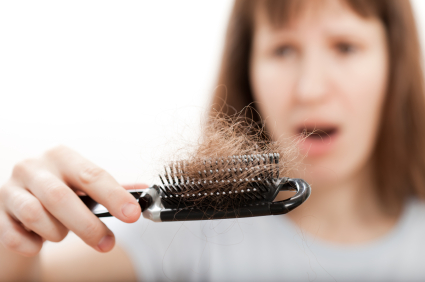
Heart palpitations are defined as “feelings of having rapid, fluttering or pounding heartbeats. Heart palpitations can be triggered by stress, exercise, medication, or, rarely, an underlying medical condition.”
In general, heart palpitations are caused by stress, anxiety, caffeine, nicotine, fever, hormonal changes, and stimulants in certain medications. So what causes heart palpitations in menopause?
“One cause of palpitations may be the rising FSH (follicle-stimulating hormone) that accompanies perimenopause, as the body tries hard to stimulate ovulation. The estrogen dominance and progesterone deficiency common to perimenopause probably add to this scenario. In a normal menstrual cycle, estrogen begins to rise markedly through the first 14 days of the cycle.
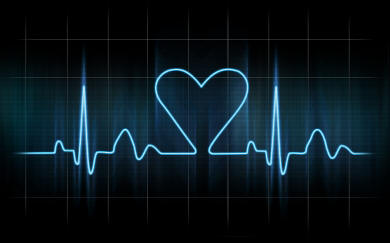
After ovulation, progesterone rises to help prepare the uterus for a potential pregnancy. Progesterone has a calming, relaxing effect and helps in the metabolism of estrogen. But in perimenopause, we have more cycles in which we don’t ovulate, so the progesterone level stays low, leading to estrogen dominance.”
Source: http://www.womenshealthnetwork.com/yourhealth/symptoms/heartpalpitations.aspx
Dry itchy skin is once again caused by hormonal changes. During menopause, itchy skin (medically known as pruritis) occurs when the levels of estrogen drop. Estrogen is vital to keep skin healthy; is responsible to stimulate collagen production.
“In the skin, estrogens affect skin thickness, wrinkle formation, and skin moisture. Estrogens can increase glycosaminoglycans (GAGs), such as Hyaluronic Acid, to maintain fluid balance and structural integrity. They can also increase collagen production in the skin, where they maintain epidermal thickness and allow the skin to remain plump, hydrated and wrinkle-free”
Source: http://www.dermalinstitute.com/us/library/76_article_Hormones_and_Your_Skin.html.

Another itchy skin symptom that affects only a small percentage of menopausal women, also due to loss of estrogen is formication. Formication “is the medical term for a sensation that exactly resembles that of small insects crawling on (or under) the skin. It is one specific form of a set of sensations known as paresthesias, which also include the more common prickling, tingling sensation of “pins and needles.”
Source: http://en.wikipedia.org/wiki/Formication
Urinary incontinence is the loss of bladder control which results in the inability to control the flow of urine. The lack of estrogen can cause the weakening of the pelvic muscles which are responsible for bladder control; menopause, however, is not the only cause for urinary incontinence. There are 5 types of urinary incontinence, namely stress, urge, overflow, functional and mixed incontinence (a mixture of more than one of the other types). The stress and urge incontinence types are generally experienced in menopause.
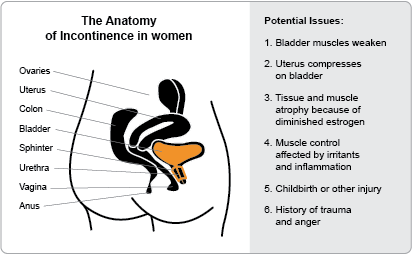
“Stress Incontinence
The most common kind of bladder control problem in older women is stress incontinence. Weakened muscles can’t hold back urine when you cough, exercise, sneeze, laugh, or lift something heavy. The result can be a small leakage of urine or a complete loss of control. This type of incontinence is most often caused by physical changes that result from pregnancy, childbirth, or menopause.
Urge Incontinence
When your bladder muscles squeeze incorrectly or lose the ability to relax (so that you always feel the urge to urinate even when your bladder is empty), you may experience leaking or loss of control. This is sometimes called an ‘overactive bladder.’ ”
Source: http://www.healthline.com/health/menopause/urinary-incontinence?toptoctest=expand#1
Forgetfulness in women in their late 40’s and early 50’s is a very common symptom that once again has been found to be caused by diminishing hormone levels. Estrogen is needed for those parts of the brain which are responsible for verbal memory and processing speed.
“A study published in the journal Menopause looked at 117 women who were close to the menopause or had just gone through it. The women were given a series of tests on verbal memory, working memory, attention, and information processing. The tests replicate daily tasks such as staying focused on something for a period of time, learning a phone number, and making a mental list of groceries, and recalling them in the supermarket.
The researchers found that women in the early stage of post-menopause performed worse on measures of verbal learning, verbal memory, and fine motor skills than women just before going through the menopause or two years into it.”
Joint aches: are experienced by both sexes in the later years of their life. Symptoms of joint pains related to menopause, however, are typically pain, swelling, stiffness, and warmth experienced in the joints.
Estrogen’s function in joints is to keep inflammation at bay. In menopause, joint pain is primarily caused by inflammation as a result of lower estrogen levels, which subsequently results in pain. Joint pain is also caused by injuries, stress, heredity, wear and tear, weight, diet, bone diseases, etc.
Here are some menopause treatment options you may be interested in…
